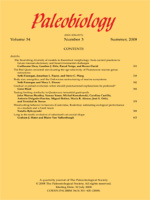Contrary to the geological stereotype of pure-carbonate reef platforms, approximately 50% of shallow shelf area in the Tropics is accumulating siliciclastic and mixed siliciclastic-carbonate sediments. Taphonomic characterization of these settings is thus essential for assessing variation among major facies types within the Tropics, as well as for eventual comparison with higher-latitude settings. Our grab samples and dredge samples of bivalve death assemblages from nine stations in five subtidal habitats in a large marine embayment of Caribbean Panama (Bocas del Toro) provide the first actualistic information on the taphonomic condition of shells in Recent tropical siliciclastic sediments. Focusing on unambiguous damage to bivalve shell interiors, we found that the quality of shell preservation in fine-grained siliciclastics is superb: commonly <10% of specimens are affected by encrustation, boring, edge-rounding, and fine-scale surface alteration via dissolution, microbioerosion, and maceration. Pure-carbonate and mixed siliciclastic-carbonate environments containing hard substrata (patch reefs, Halimeda gravelly sand, mud among patch reefs) contain higher numbers of more severely damaged shells (generally >25%) and also higher diversities of fossilizable encrusters and borers. Disarticulation and fragmentation are pervasive across all environments and are probably related to predation rather than to postmortem processes. As in other shallow subtidal study areas, the taxonomic compositions of death assemblages have not been homogenized by postmortem transport but show high spatial fidelity to the distribution of living species. Assemblages from the five sedimentary environments have distinct taphonomic signatures, but the strongest differences are between the two fine-grained, exclusively soft-sediment siliciclastic environments on the one hand and the three environments containing hard substrata on the other. Experimental tests for rates and agents of damage, still in progress, indicate that the most critical environmental variables are exhumation cycles and burial rate. Bivalve death assemblages from Bocas del Toro demonstrate that damage levels in tropical fine-grained siliciclastic environments are much lower than in closely associated reefs and algal sands, and suggest a less filtered record of biological information.
How to translate text using browser tools
1 March 2000
Bivalve taphonomy in tropical mixed siliciclastic-carbonate settings. I. Environmental variation in shell condition
Mairi M. R. Best,
Susan M. Kidwell
ACCESS THE FULL ARTICLE

Paleobiology
Vol. 26 • No. 1
March 2000
Vol. 26 • No. 1
March 2000




